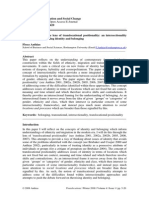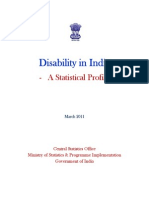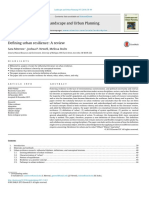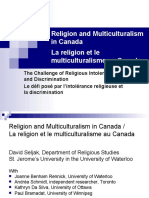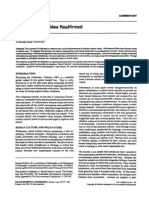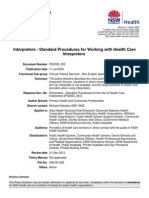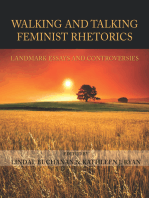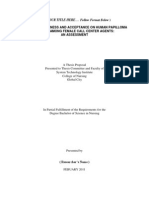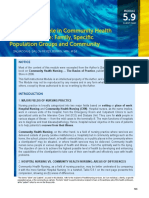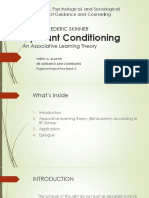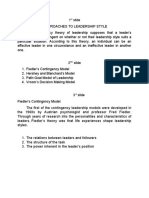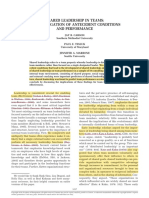Intellectual Disability Research Proposal PDF
Intellectual Disability Research Proposal PDF
Uploaded by
Overall Clinical CoordinatorCopyright:
Available Formats
Intellectual Disability Research Proposal PDF
Intellectual Disability Research Proposal PDF
Uploaded by
Overall Clinical CoordinatorOriginal Description:
Original Title
Copyright
Available Formats
Share this document
Did you find this document useful?
Is this content inappropriate?
Copyright:
Available Formats
Intellectual Disability Research Proposal PDF
Intellectual Disability Research Proposal PDF
Uploaded by
Overall Clinical CoordinatorCopyright:
Available Formats
Bachelor in Science (Nursing) B.Sc. (Cur.
)
NU4S01- Research Proposal
A qualitative study to explore the experiences of care staff that
have supported people with a profound intellectual disability
through the bereavement process.
Research Proposal submitted to University of Dublin Trinity College in partial
fulfilment of the requirements for the Bachelor in Science (Nursing) B.Sc. (Cur.)
ii
I hereby declare that this Research Proposal is entirely my own work and has not been
submitted as an exercise for assessment at this or any other university.
Name:
Signed:
Date:
iii
Acknowledgements
I would like to thank the lecturers of Trinity College Dublin, my facilitator, my family and
friends for their continued support in my completion of this project.
iv
Table of Contents
TITLE.........I
DECLARATION OF OWN WORK.........II
ACKNOWLEDGEMENTS .................................................................................................................. III
TABLE OF CONTENTS .................................................................................................................... IV
ABSTRACT ...................................................................................................................................... V
CHAPTER ONE .............................................................................................................................. 1
INTRODUCTION AND IDENTIFYING ISSUE OF INTEREST ................................................................. 1
LITERATURE REVIEW ..................................................................................................................... 1
CONCLUSION .................................................................................................................................. 7
RESEARCH QUESTION .................................................................................................................... 7
AIM OF THE STUDY ........................................................................................................................ 8
OBJECTIVES OF THE STUDY ............................................................................................................ 8
SUMMARY ...................................................................................................................................... 8
CHAPTER TWO: METHODOLOGY .......................................................................................... 9
INTRODUCTION ............................................................................................................................... 9
RESEARCH DESIGN ......................................................................................................................... 9
POPULATION/ SAMPLE ................................................................................................................... 9
DATA COLLECTION PROCEDURES ................................................................................................ 11
PILOT STUDY ................................................................................................................................ 12
DATA ANALYSIS PROCEDURES .................................................................................................... 13
ROBUSTNESS OF STUDY ............................................................................................................... 14
ETHICAL CONSIDERATIONS .......................................................................................................... 15
CONCLUSION ................................................................................................................................ 16
CHAPTER THREE ....................................................................................................................... 17
INTRODUCTION ............................................................................................................................. 17
PROPOSED OUTCOMES OF THE STUDY ......................................................................................... 17
DISSEMINATION ........................................................................................................................... 17
TIME SCALE .................................................................................................................................. 18
PROPOSED BUDGET ...................................................................................................................... 19
CONCLUSION ................................................................................................................................ 20
APPENDICES ................................................................................................................................ 21
APPENDIX 1. LETTER TO RESEARCH COMMITTEE......................................................................... 21
APPENDIX 2: LETTER TO HOSPITAL ETHICS COMMITTEE ............................................................ 23
APPENDIX 3: LETTER TO TRINITY COLLEGE FACULTY OF HEALTH SCIENCE .............................. 25
APPENDIX 4: LETTER TO DIRECTOR OF NURSING ........................................................................ 26
APPENDIX 5: LETTER OF EXPLANATION/INVITE TO PARTICIPANTS ............................................. 28
APPENDIX 6: TRINITY COLLEGE CONSENT FORM ........................................................................ 29
APPENDIX 7: INTERVIEW GUIDE ................................................................................................... 31
APPENDIX 8: COLAIZZIS (1978) FRAMEWORK ............................................................................ 32
APPENDIX 9: THE ETHICS CHECKLIST ADAPTED FROM HANSON (2006) ..................................... 33
APPENDIX 10: STORAGE OF INFORMATION .................................................................................. 35
REFERENCE LIST: ......................................................................................................................... 36
v
Abstract
Background: The proposed study aims to explore the experiences of care staff that have
supported people with a profound intellectual disability through the bereavement process.
Historically it was assumed that people with intellectual disabilities did not have the
cognitive ability to grieve, however it is now accepted that an understanding of the concept
of death is not a precondition to grieving. Death and dying are an unavoidable aspect of the
human experience; people can face multiple losses within their lifetime, yet the aftermath
of bereavement seems to be largely neglected for the person with ID. A review of the
literature surrounding the bereavement needs of people with intellectual disabilities
illustrated that this topic is gaining momentum. Nevertheless, the paucity of studies
involving people with profound intellectual disabilities accentuates that the bereavement
needs of this group of people has been largely neglected in research.
Methods: The researcher proposes a qualitative descriptive design for the study. The
sample will comprise of nine care staff using a non-probability purposive sampling
technique. Data collection will entail the researcher conducting one to one semi-structured
interviews which include open-ended questions with the participants. Data analysis will be
guided by Colaizzis (1978) framework. Ethical approval for the study will be sought from
Trinity College and from the hospital research committee.
Conclusion: It is hoped that this study will enhance current knowledge of the bereavement
needs of people with a profound intellectual disability and serve as a catalyst for further
research on the topic.
Keywords: bereavement, grief, care staff, profound intellectual disability
1
Chapter One
Introduction and Identifying Issue of Interest
Bereavement and loss have a significant impact on the lives of people with intellectual
disabilities (ID) (Brickell & Munir 2008). Stressful life events such as bereavement can
have a detrimental effect on the psychological well-being of people with ID (Hulbert-
Willimas & Hastings 2008), nonetheless Arthur (2003) asserts the emotional lives of
people with ID have been primarily neglected in research.
The researcher has particular interest in this topic as having been in a working situation
where a person with a profound ID had been bereaved the researcher realised she was
unaware of how to best meet the needs of this individual or of individuals in this situation
in future practice. The lack of knowledge as regards the bereavement experiences and
support for people with ID was recognised which highlighted the importance of continuity
of care between all stakeholders in supporting the bereaved person. Clements (2004)
highlights that there is a dearth of literature surrounding the bereavement process for
people with ID. In this chapter the researcher will present the aim of the proposed study
and a review of the literature on bereavement and people with intellectual disabilities. The
research question with the aim and objectives of the proposed study will follow the
literature review.
Aim
The aim of the proposed study is to explore the experiences of care staff that have
supported people with a profound intellectual disability through the bereavement process.
Literature Review
A literature review provides a background of current knowledge on a topic and highlights
the necessity for new studies (Polit & Beck 2010). The aim of this literature review is to
identify and examine research previously undertaken surrounding bereavement and people
with intellectual disabilities. To obtain the research articles used in this review, electronic
searches were carried out using online databases such as CINHAL, PsycArticles and Wiley
Interscience in conjunction with manual searches for articles from relevant journals. The
2
articles used in this review are peer reviewed and date back over a ten-year span from
1999-2009.
Twenty-six articles were found to be of relevance to the topic area. Of these articles,
sixteen were of a qualitative nature, six used a quantative research design and three
employed a mixed method approach, Dodd et al. (2005), Dowling et al. (2006) and
Reynolds et al (2008). The main themes which emerged from the review were involvement
in rituals, disenfranchised grief and supporting people with ID through the bereavement
process. The researcher will now through a thematic approach develop these themes.
Rituals:
Dodd et al. (2005) conducted a mixed-method study to examine staff and organisational
attitudes and practices in relation to bereavement and people with ID in the Republic of
Ireland. The study contained quantitative multiple choice questionnaires and likert-scale
questions which were combined with qualitative open-ended questions. The sample
consisted of sixty care staff from within one health board area and seventeen organisations
which were geographically dispersed throughout the country. The results of the study
showed high levels of participation in grief rituals by bereaved individuals with ID and
staff had positive attitudes regarding inclusion in rituals. However, staff did not discuss the
possibility of challenging behaviour or mental health problems as a consequence of
bereavement. The researchers assert that staff education and training along with the
development of individualised support for people with ID is crucial.
Comparable results were produced in a study by McGarry & Taggart (2007); all eleven
participants in this qualitative study were included in some part of the funeral process such
as an opportunity to view the deceased, presence at the church service, funeral cortege and
at the graveside. However, an English study carried out by Raji et al. (2003) suggests it is
not uncommon for a person with ID to be denied the chance to partake in the funeral of a
family member. The high levels of participation in rituals in Irish studies could be linked to
the influence of religious organisations in service provision in the past in Ireland (Dodd et
al. 2005).
An American study by Clements et al. (2004) in which three case studies are presented
also supports this claim. They propose that it is not uncommon for the person with ID not
to be informed about the death of a loved one until considerable time has passed resulting
3
in them being excluded from the funeral process. Dodd et al. (2008) advises conducting a
bereavement ritual history on an individual basis to take into consideration the persons
previous involvement in mourning rituals while striving to develop the comprehension of
such rituals is crucial to minimise distress. The way people are informed or not informed
can have profound effect on how they cope with their grief in the months and years to
come (Read 2000).
Grief:
Dokas (1989) work on disenfranchised grief is cited in some of the literature obtained by
the researcher surrounding grief therefore the researcher has included it although it is past
the ten year limit for this review. Disenfranchised grief is described as grief that cannot be
freely acknowledged, publicly mourned or socially facilitated (Doka, 1989 as cited in Todd
2004; Read 2005; Read & Elliott, 2007). Doka highlights that disenfranchisement occurs
when the bereaved person is not deemed capable of grieving. Therefore as people with ID
are a marginalised group who are not legitimised by society they are at an increased risk of
disenfranchised grief (Read & Elliott 2007).
Historically it was hypothesised that as a consequence of their limited cognitive ability,
people with ID did not grieve (Read 2005). Knowledge of the concept is not precondition
to experiencing the emotions associated with grieving; people with ID will grieve for the
loss of the deceased with or without an understanding of the concept of death (Dodd et al.
2005). Read & Elliot (2007) highlight that for healthy grieving to occur it is essential that
professional carers find ways of enfranchising people with ID.
Dodd et al. (2008) conducted a study of complicated grief symptoms in people with ID,
applying a quantitative research design seventy six participants were involved. They
identified this to be the first study of this nature, half of the group had encountered parental
bereavement within the previous two years; the remaining thirty eight people were the
comparison group and involved individuals of the same age group who had not been
bereaved within this time frame. The sample was recruited from two voluntary agencies in
Dublin providing day and residential services. The aim of the study was to examine precise
symptoms associated with complicated grief; a bereavement history and involvement in
rituals were also studied for possible association the development of symptoms.
4
Complicated grief is defined by Dodd et al. (2008) as the occurrence of particular grief
related symptoms after a certain period of time has elapsed. It is generally accepted that
within one to two years of bereavement the significant symptoms of grief should have
passed. These symptoms include, longing for the deceased, loneliness, disbelief, anger
feeling insecure and detachment from others. The results of this study revealed one third of
the bereaved group experienced ten or more clinical symptoms. A significant strength of
this study is the use of a comparison group which enabled strong conclusions to be drawn
from the data; nevertheless all information gathered was based on carer observations. In
view of the sample involving only higher ability adults with ID, it cannot develop our
knowledge regarding the bereavement experiences of adults with a severe or profound ID
(Dodd et al. 2008).
The term traumatic grief is described by Prigerson et al. (1999) as involving two core
components, separation distress and traumatic distress. Dodd et al. (2005) suggest further
research is crucial to accurately describe symptoms of traumatic grief for people with ID.
This request is supported by Brickell & Munir (2008) in a review of grief and its
complications in people with ID, they agree that such a description will enhance
knowledge of how this group of individuals experience bereavement. The study proposed
that people with ID have an elevated risk of traumatic grief due to the possibility of
secondary loss, difficulty in communicating about the loss and their cognitive ability to
make sense of the loss.
Meeusen-van de Kerkhof et al. (2006) study of the perceptions of death and management
of grief in people with ID examined the way people with different levels of ID cope with
death and mourning. The researchers provide a framework for how people at each level of
ID, profound to mild experience and perceive death and their perceptions of grief and
bereavement with advisable means of counselling provided also. The researchers recognise
that each individual has different experiences which shape development therefore the
stages provided by them should not be considered absolute. Further research into this
relatively unexplored area is recommended.
An additional stressor is the multiple losses, which people with ID experience. Four of the
participants in McGarry & Taggarts (2007) study were moved out of their family home
into a residential service after the death of a loved one. The loss of familiar environment
and social networks may contribute to further distress for the person. This is echoed by
5
MacHale & Carey (2002) and Stoddart et al. (2002) they propose that extensive losses for
instance the death of a parent, loss of their home, possessions and familiar routines can
complicate the bereavement process for people with ID. Blackman (2008) proposes that
linked with complicated grief is the level and type of support offered to the bereaved
person.
Support:
Carers need to recognise that people with ID are capable of grieving and can react to death
in a very profound way (Reed 2000). McGarry & Taggart (2007) conducted a study using a
qualitative approach with a retrospective design. A retrospective design involves
researchers looking for information from the past to study a current phenomenon (Parahoo
2006). The researchers conducted semi-structured one to one interviews with eleven people
with ID who were living in community services in the west of Ireland. The aim of the
study was to explore the support clients received from front-line staff around the time of
bereavement and to explore the bereaved persons perceptions of the support offered.
Some of the studys findings included how staff encouraged the person to remember the
deceased through the use of personal keepsakes and photographs. Positive and negative
effects were reported by participants from these, some felt it enabled them to reminisce on
happy times while three participants reported it to be a painful depressing experience. One
participant reported feeling staff were supportive at the time of bereavement but she felt
they did not identify with her as the grieving process transpired. McGarry & Taggart
(2007) emphasise that staff education and training on various aspects of supporting the
bereaved person is necessary in conjunction with collaboration between all stakeholders
and the bereaved person will enable an integrated approach to care.
In a clinical review Read (2000) discusses ways for carers to assist people with ID cope
with bereavement and suggests some appropriate professional responses. All carers should
conduct an assessment to determine what the individuals needs are at the time. Effective
communication, which is simple to understand clear and consistent is essential. Talking to
the person illustrates an acknowledgement of their loss and invites them to grieve thus
enabling the carer to explore the persons prior experiences and current understanding of
death. Summers & Witts (2003) support this claim; they suggest the finality of death needs
to be explained to the bereaved person.
6
Bereavement counselling can be a beneficial method of encouraging people with ID
identify and manage their grief (Read 2005, Read & Elliott 2007). Participants in Read
(2001), Summers & Witts (2003) and Dowling et al. (2006) reported that bereavement
counselling had a positive effect on their lives. Carers also observed positive results such
as a decrease in anxiety and irritability combined with increased communication regarding
their feelings. Friendships and new interests developed signifying a vast improvement in
the individuals quality of life. Nevertheless McGarry & Taggart (2007) emphasise that the
lack of continuity between counselling sessions and residential settings can cause
unnecessary stress for the person. Counsellors also need training to enable them to develop
a therapeutic relationship with individuals with ID (Dowling et al. 2006). Read (2000)
highlights that the professional carer spends the majority of the time with the individual
therefore they are a central part of the overall bereavement support. Dodd et al. (2005)
advises that there can be a reliance on counselling rather than establishing more beneficial
life style changes.
Bonell-Pascual et al. (1999) recommend that when caring for individuals with challenging
behaviour the long-term effects of bereavement should not be overlooked. MacHale &
Carey (2002) assert people with ID are at risk of diagnostic overshadowing as carers may
inadvertently associate behavioural expressions of grief as challenging behaviour or
psychiatric disturbances. They examined the effects of bereavement on challenging
behaviour and mental health. The sample consisted of twenty adults with ID who had been
bereaved within the pervious two years and a control group of twenty adults who had not
experienced significant life events in the pervious two years. A substantial increase in
challenging behaviour among those that had been bereaved was found. Irritability, crying
lethargy, hyperactivity and temper tantrums were the most commonly observed
behaviours. Blackman (2005) asserts that carers of people with ID often fail to recognise
signs of grief in those they are supporting. Failing to provide information and support only
serves to intensify the vulnerability of this population (Mappin & Hanlon 2005).
MacHale et al. (2009) in a quantative study explored caregiver perceptions of service users
understanding of death, levels of support required and staff confidence in proving support
following bereavement. Forty-two staff rated people with ID whom they worked with
regularly. The findings suggest carers tended to overrate knowledge levels and highlight
that staff lacked confidence in providing post bereavement support. A limitation of the
study involves potential bias with the participant selection as they were nominated by the
7
staff and the majority had a mild ID. However, the study emphasises the significance of
research focusing on staff appraisal of service user abilities and the need for further
research.
Only one service out of the seventeen involved in Dodd et al. (2005) study had an official
bereavement policy. The researchers recommend that services need to formalise their
procedures on bereavement care to ensure quality of service which shows consideration for
bereaved clients. Blackman (2008) is in the process of developing an assessment tool to
assist professionals in identifying specific bereavement needs for an individual with ID.
The purpose of developing such a tool is to enable carers to appreciate the impact of the
loss on the individual at the time it occurs. The feasibility study has highlighted areas that
need to be adapted and the researcher is currently refining the BNAT.
Conclusion
In the past it was believed that people with ID did not have the cognitive ability to grieve,
they were a marginalised group who were not legitimised by society. The researcher
discussed the themes of involvement in rituals, grief and supporting people with ID
through bereavement as these appeared frequently within the studies obtained for this
literature review. It was noted that many studies recommended further research in the area
and to involve people with a profound intellectual disability. Numerous studies, (Read
2000, Bennett 2003, Read 2005, Dodd et al. 2008, MacHale et al. 2009) address the
significant role care staff have in the lives of people with an ID. Furthermore studies by
Murray et al. (2000) and Dodd et al. (2005) highlight that care staff have a great deal of
knowledge surrounding the grieving process and of post bereavement support for people
with ID. As a result of dearth of studies pertaining to people with a profound ID combined
with the significance of the role of the care staff, the researcher proposes to conduct a
qualitative study to explore the experiences of care staff that have supported people with a
profound intellectual disability through the bereavement process.
Research Question
The research question assists the researcher to focus on the questions which need to be
answered and is therefore fundamental to the research process (Parahoo 2006). The
research question posed here is: What are the experiences of care staff that have supported
people with a profound intellectual disability through the bereavement process?
8
Aim of the Study
The aim of this study is to explore the experiences of care staff that have supported people
with a profound intellectual disability through the bereavement process.
Objectives of the Study
To explore the experiences of care staff that have supported people with a profound
intellectual disability through the bereavement process.
To explore the supports offered by care staff to the person with a profound
intellectual disability that has been bereaved.
To establish if care staff feel adequately trained to facilitate the bereaved person.
To explore the resources available to care staff in supporting people with a
profound intellectual disability that have been bereaved.
Summary
Within chapter one the researcher presented a literature review on bereavement and people
with intellectual disabilities. The themes of ritual involvement, grief and support were
discussed. The researcher presented the research question, aim and objectives of the
proposed study, A Qualitative study to explore the experiences of care staff that have
supported people with a profound intellectual disability through the bereavement process.
9
Chapter two: Methodology
Introduction
This chapter presents the proposed research method and design of a qualitative research
study to explore the experiences of care staff that have supported people with a profound
intellectual disability through the bereavement process.
Research Design
A research design is a plan that explains the how, when and where data are to be collected
and analysed, the researcher must choose the most appropriate design to meet the aims and
objectives of the study (Parahoo 2006). A research design can involve a quantitative design
or qualitative design. Qualitative research is a broad term used to describe research that is
focused primarily on human experience through exploring attitudes, beliefs, values and
experiences (Whitehead 2007). Qualitative research is more in-depth and holistic than
quantitative, generating rich material on which to base the findings of a piece of research
(Polit & Beck 2010).
Sandelowski (2000) asserts that qualitative descriptive studies present a comprehensive
summary of an event in everyday terms of those events. The researcher has chosen a
descriptive qualitative design for this study as it proposes to explore the experiences of
care staff that have supported people with a profound intellectual disability through the
bereavement process. Whilst conducting the literature review on the topic the researcher
noted the majority of the articles obtained employed a qualitative approach to the research.
Population/ Sample
Polit & Beck (2010) illustrate that a sample is a portion of the population chosen to
represent the entire population. The purpose of sampling is to attain data from a smaller
particular sample which in turn increases efficiency by allowing generalisations to be made
about the population without having to examine every member. Sampling technique will
affect the validity of the research therefore it should be undertaken with maximum rigour
(Procter & Allan 2007).
For the purpose of this study the researcher has chosen to use non-probability purposive
sampling for the following reasons, Procter & Allan (2007) highlight that in qualitative
research non-probability sampling is used to study the population of interest and to
10
ascertain that the research samples rich sources of data. While purposive sampling is
predominantly used in qualitative research as it involves the researcher intentionally
selecting who to include in the study on the basis that those selected can present the
requisite data (Parahoo 2006).
According to Parahoo (2006) in the preparation of a study deciding on the number and
characteristics of participants is one of the most fundamental decisions. In qualitative
studies, samples are typically small and based on information needs (Polit & Beck 2010).
Whitehead & Annells (2007) suggest a common range in qualitative research is usually
between eight and fifteen participants but this can vary. The small sample size is suitable
because of the potentially detailed data that can be generated from each participant.
The population of interest in this study is care staff in intellectual disability services that
have supported people with a profound intellectual disability through the bereavement
process. The researcher has chosen a sample size of nine and proposes to accept the first
nine people who meet the inclusion and exclusion criteria. The establishment of inclusion
and exclusion criteria will increase the precision of the study and strength of evidence
(Haber 2006).
Inclusion criteria: This refers to specific characteristics or criteria that participants must
possess to be included in the study. For the proposed study the characteristics that the care
staff will be required to meet include:
Care staff who are working full time in a residential setting for people with a
profound intellectual disability and involved in direct client care.
All participating care staff must have at least 3 years experience caring for people
with a profound intellectual disability and are currently working with this client
group.
Exclusion criteria: Participant characteristics or attributes that are not suitable for
inclusion (Polit & Beck 2010)
Staff who are not involved in direct client care and care staff that have no
experience caring for people with a profound intellectual disability.
Participants who have less than 3 years of experience caring for people with
profound intellectual disability.
11
Gaining entre usually involves negotiations with gatekeepers (Polit & Beck 2010),
gatekeepers are individuals or groups who control access to participants and data (Hunn
2007). The co-operation of gatekeepers in the selected site is a prerequisite. A Dublin
based residential service catering for people with intellectual disabilities will be the site for
this proposed study. Once the researcher has gained ethical approval from the Hospital
Ethics Committee (Appendix 2) the Director of Nursing will be contacted (Appendix 4).
Participants will be recruited by sending a letter of explanation (Appendix 5) to relevant
units which cater for people with a profound intellectual disability. This letter of
explanation/invite concerning the study will then also be provided for all who decide to
partake in the proposed study, along with a letter of consent (Appendix 6). A requirement
of the Bachelor of Science programme is approval from Trinity College, therefore, a letter
seeking approval (Appendix 3) will be sent to the Faculty of Health Sciences.
Data Collection Procedures
Polit & Beck (2010) highlight the goal of data collection is to generate data that is of
exceptional quality. Qualitative research relies on methods that permit researchers into the
personal lives of the participants. To facilitate this process flexible and varied strategies are
required (Parahoo, 2006). These data collection methods include interviews, observations,
focus groups and action research.
Interviews are a common method of data collection in nursing research, the individual
questions must be clear to the respondent, free of suggestion and use correct grammar
(Whittemore & Grey, 2006). Semi-structured interviews allow the researcher to have a
framework in which necessary open-ended questions are posed to encourage the
participants to talk freely about their experiences (Polit & Beck 2010). Face to face
interviews are beneficial when the researcher is interested in obtaining more personal
information from the respondent. Open-ended questions are frequently used in qualitative
research studies when the researcher wants the participants to respond in their own words,
thus enabling richer and more complex data to be collected (Whittemore & Grey, 2006).
As a result of this the researcher has chosen semi-structured interviews with open-ended
questions which will take place on a one to one basis as the data collection method. Davies
(2007) asserts that the researcher must be able to engage with the interviewees in a setting
that is relaxed and familiar to them, free from distractions and conducive to a conversation
12
to allow the participant to talk freely about possibly emotional and confidential matters.
Permission for the use of a suitable room within the organisation to conduct the interviews
in will be sought from the Director of Nursing (Appendix 4).
Davies (2007) suggests interviews which are audio tape recorded are common in
qualitative research to enable the researcher to pay full attention to the participant and note
non-verbal behaviour. The audio recording facilitates a detailed account of the participants
responses and a verbatim transcript for analysis (Meadows 2003). This will also prevent
the researcher from being biased by means of poor notes or memory of the interview.
Therefore the researcher will audio record all interviews in the proposed study. The
duration of the interview will vary on an individual basis; Cormack (2000) suggests time
restrictions may hinder the free flowing nature of the interview. It is hoped that the
interviews will last approximately forty minutes or until there is data saturation.
Interview Guide
The interview guide will contain a list of open-ended questions which have been derived
from the aims and objectives of the study. These open-ended questions must be balanced,
unbiased, sensitive and clear (Whitehead & Annells 2007) (See Appendix 7).
Pilot Study
A pilot study can be described as a small scale version or trail run, done in preparation for
a major study. A pilot study can be used to improve a project, assess its feasibility,
improve its clarity, eradicate problems and refine methodology (Polit & Beck 2010).
The researcher proposes to conduct a pilot study with one staff member who fits the
inclusion criteria, this person will then be omitted from the proposed study. Any findings
will also be excluded also. The pilot study will be carried out in the same location as the
proposed study using the same interview guide. This will enable the researcher to test that
the audio-recording equipment is working and picking up both voices, the interview guide
is applicable and asses the suitability of the environment (Davies 2007). This will enable
the researcher to determine the approximate length of the interview. The participants will
also be invited to give their opinion on the interview, the setting and the interview guide. It
is intended that the pilot study will facilitate the researcher to identify problems which can
then be amended before the proposed study commences.
13
Data Analysis Procedures
Data analysis is conducted to reduce, record, organise and give meaning to data.
Qualitative researchers must maintain a balance between the need to be concise and to
preserving the richness of their data (Polit & Beck 2010). According to Parahoo (2006) a
significant characteristic of qualitative data analysis is that data collection and analysis are
conducted simultaneously and after data collection is completed. One of the more common
frameworks used in nursing research to analyse data from qualitative studies is that of
Colaizzi (1978). The basic outcome of this method is the description of the meaning of an
experience often through the identification of useful themes. Themes are a way of
describing large quantities of data in a condensed manner (Streubert Speziale 2006). The
researcher has chosen to use Colaizzis (1978) framework for data analysis (Appendix 8).
The principles of the Data Protection Acts of 1988 & 2003 (amendment) will be adhered to
in this research proposal. Pseudonyms will be given to each participant to reduce the risk
of personal data being lost. All data will be stored in a locked safe which can only be
accessed by this researcher. This storage will remain in place for the requisite time of one
to five years as this is in keeping with the recommendations of the Data Protection Acts.
After this time all electronic data will be overwritten and all manual data will be shredded,
in accordance with the Data Protection Acts.
Streubert and Carpenter (2003) assert that all tapes should be duplicated in case of damage.
All tapes will be transcribed verbatim which will then be entered into a computer through a
word processing program. There are various computer programs which are available to
support qualitative data analysis. For the purpose of this proposal the researcher proposes
to use NVivo 7, to assist with the data analysis. Davies (2007) suggests NVivo is an
extremely powerful database, it enables researchers to handle large data sets, perform
complex searches and organise material. Once themes have been identified by the
researcher the software is able to search for reoccurrences. Description of the phenomenon
under study will be made and as guided by Colaizzis (1978) method all participants will
be asked to confirm findings.
14
Robustness of Study
Rigour refers to the extent which the researcher strives for excellence and how they adhere
to detail and accuracy. Parahoo (2006) highlights that although rigour can be difficult to
determine in qualitative research, researchers want their findings to reflect truthfully the
phenomenon they are studying and to contribute to knowledge that is beneficial to others.
The researcher proposes to use a framework by Lincoln and Guba (1985) as cited in
Parahoo (2006, p.410) and Polit & Beck (2010, p.492) to increase the trustworthiness of
this study. This framework encompasses the following four criteria for developing
trustworthiness of a qualitative study, credibility, dependability, confirmability and
transferability.
Credibility refers to confidence in the truth of the data and interpretations of them.
According to Polit & Beck (2010) it is considered by Lincoln and Guba to be fundamental
goal of qualitative research furthermore member checking is deemed an important
technique for establishing credibility in qualitative research. Member checking can be
undertaken both throughout the data collection and after data analysis has occurred in a
follow-up conversation. The researcher proposes to use member checking to gain
credibility in the proposed study through contacting the participants by telephone to verify
the findings and clarify their descriptions.
Dependability is concerned with the ability of the data to remain stable over time, would
the study findings be replicated if undertaken with similar participants in a similar context.
Credibility cannot be attained in the absence of dependability. The researcher proposes to
use an audit trail to enhance the dependability of the study. This involves tracking and
recording all decisions which have influenced study so an outside individual can examine
the data (Dempsey & Dempsey 2000). The researcher will keep a record of all decisions
regarding the proposed study with all other information in a locked press (Appendix 10).
Confirmability refers to the data representing the information participants provided. There
should be no biases or subjectivity in the study; the findings must represent the participants
voice (Polit & Beck 2010). The researcher will uphold this principle by clarifying all
information with the participants. Transferability involves the extent to which the findings
of a qualitative study can be useful to similar groups or situations (Parahoo 2006). It is
hoped that the proposed study will enhance knowledge and subsequently result in
15
developments in practice for people with a profound intellectual disability that are
bereaved.
Ethical Considerations
Ethical issues in research relates to the protection of human participants to ensure the
absence or lessen the possibility of harm, anxiety, discomfort or trauma (Coup &
Schneider 2007). Parahoo (2006) asserts there are ethical implications at each stage of the
research process from the choice of topic to selection of design and publication of the
findings. It is ultimately the responsibility of the researcher to protect their participants and
conduct all research in an ethical manner (Dempsey & Dempsey 2000). The researcher is
cognisant that each research approach and every study has its own ethical implications
(Parahoo 2006) therefore the researcher proposes to implement and abide by the following
ethical principles:
Autonomy: Participants should be given clear unambiguous information regarding the
research, comprehend the information and the option to consent or decline participation
voluntarily (Polit & Beck 2010). Informed consent will be sought from every participant,
at initial contact the researcher will explain the study verbally, then providing them with a
copy of the consent form (Appendix 6). Hunn (2007) advises the consent form should be
clear, concise and easy to read with no jargon. These forms will be stored in a locked press
which only the researcher has access to. The researcher will also explain to participants
they have the right to withdraw from the study at any time.
Beneficence: Polit & Beck (2010) assert a fundamental ethical principle in research is
beneficence, where the onus is on researchers to minimise harm and maximise benefits for
the participants themselves, other individuals or society as a whole. The sole aim of this
study is to be of benefit. The researcher hopes that this study will be of benefit to the
nursing profession and subsequently improve the lives of people with a profound
intellectual disability.
Non-maleficience: Research should not cause any harm to participants either physical or
psychological (Parahoo 2006). The researcher is aware that the topic bereavement may be
difficult for the participant, she will listen attentively to the participant, questions will be
phrased in a caring manner and probing questions will only be used when it is deemed
16
necessary. The researcher will also provide an opportunity for the participant to voice any
concerns or queries they have regarding the proposed study.
Fidelity: This involves the building of trust between the researcher and the participants
(Parahoo 2006). The researcher should always put the safety and well-being of the
participant above the completion of the study. The researcher will uphold this principle by
ensuring the participant is aware they can withdraw from the study at any given time and
no information will be used within the study.
Confidentiality: Confidentiality is essential; the researcher will safeguard participants
identities and responses from public disclosure (Dempsey & Dempsey 2000). Assurances
will be offered by the researcher that confidentiality will be respected at all times and that
in no way will the participants be identified or identifiable. Pseudonyms will be used
throughout the study. Participants will be assigned an identification number which will be
used throughout the study and no identifying information will be entered onto computer
files. Encryption technology will be used to protect electronic data in keeping with the
Policy on Good Research Practice (Trinity College 2009).
Conclusion
This chapter has provided the rationale for the researchers choice of data collection and
data analysis methods to conduct the proposed study which is a qualitative study to explore
the experiences of care staff that have supported people with a profound intellectual
disability through the bereavement process. It outlined the steps the researcher will
undertake to perform the proposed study, a pilot study will be conducted and the ethical
principles guiding the study were outlined also.
17
Chapter Three
Introduction
The proposed outcomes of the study and dissemination of the findings as directed by the
hospital research committee will be described in this chapter. A timescale and budget for
the proposed study are provided.
Proposed Outcomes of the Study
The purpose of this study is to explore the experiences of care staff that have supported
people with a profound intellectual disability who have been bereaved. Using the inclusion
and exclusion criteria the sample should produce the requisite participants. Through the
use of the interview guide and probing questions, rich descriptions of the experiences of
care staff that have supported people with a profound intellectual disability through the
bereavement process are expected. The aim and objectives of the proposed study should
subsequently be answered by these descriptions. It is hoped that this study will in some
way address the void in the current literature regarding bereavement and people with
profound intellectual disabilities and serve as a catalyst for further studies on the topic.
Dissemination
Dissemination of findings involves the distribution of findings in a range of formats such
as conference presentations, seminars and published papers (Parahoo 2006). In order to
enhance evidence based nursing practice the researcher aims to share the results of the
proposed study by dissemination of the research findings. It is proposed to forward the
findings of this study to the participants and the hospital ethics committee. A copy of the
study will be donated to the hospital library. It is also proposed to present the findings at a
relevant national conference and to relevant journals.
18
Time Scale
The researcher proposes a period of eighteen months to carry out the proposed study. The
researcher believes that this time frame should provide adequate time for the study.
2010 2011
J
u
n
J
u
l
A
u
g
S
e
p
O
c
t
N
o
v
D
e
c
J
a
n
F
e
b
M
a
r
A
p
r
M
a
y
J
u
n
J
u
l
A
u
g
S
e
p
O
c
t
N
o
v
Literature
Review
* *
Ethical
Considerations
* *
Pilot Study * *
Refining Data
Collection
Methods
* *
Data Collection * * * * *
Data Analysis * * * * *
Transcription
and Analysis
* * *
Preparation of
final report
* *
19
Proposed Budget
Bond & Gerish (2007) suggest preparing a budget involves translating the plan of work
and timescale into monetary terms. See table below for estimated costs.
Item Budgeted Amount
Stationary 80.00
Postage and S.A.E 20.00
Photocopying 40.00
Digital Voice Recorder 50.00
Digital Voice Tapes 40.00
Computer Software (NVivo 7) 415.00
Telephone Costs 150.00
Travel Expenses 100.00
Allowance for unforeseen circumstances 200.00
Total: 1,095.00
20
Conclusion
The researcher proposes to conduct a qualitative study to explore the experiences of care
staff that have supported people with a profound intellectual disability through the
bereavement process. On reviewing the literature surrounding bereavement and people
with intellectual disabilities the researcher became aware of a void within current research
on the bereavement needs of people with a profound intellectual disability. The proposed
method of data collection by conducting semi-structured interviews was discussed. Data
analysis will be guided by Colaizzis (1978) framework and the use of a computer package
to assist with data analysis was described. Lincoln and Guba (1985) criteria will be applied
to enhance the robustness of the study. The researcher addressed ethical principals and will
uphold these throughout the study process.
The methodological issues within the proposed study involves the chosen methodology
and sample size. Given the small sample size the issue of generalisability arises. However
Parahoo (2006) highlights if the study is carried out well it can be of significant value
beyond the sample studied. The researcher proposes to use member checking to verify the
data collected thus enhancing the robustness of the study. Further research is advised to
increase knowledge of the bereavement needs of people with a profound intellectual
disability.
21
Appendices
Appendix 1. Letter to research committee
Researchers Address,
Xxxxxxxxxxxxxxxxx,
Xxxxxxxxxxxxxxxxx.
The Hospital,
Xxxxxxxxxxxxxxxxx.
Xxxxxxxxxxxxxxxxx.
Dublin.
dd.mm.yyyy.
Re: Reserach Study: A Qualitative study to explore the experiences of care staff that have
supported people with a profound intellectual disability through the bereavement process.
Dear members,
My name is ......................, I am currently undertaking a Bachelor in Science (Nursing)
B.Sc. (Cur.) in Intellectual Disability Nursing at Trinity College Dublin. As part of the
course I am required to carry out a research proposal. My proposed study is a qualitative
study which aims to explore the experiences of care staff that have supported people with a
profound intellectual disability through the bereavement process.
I hope that the results of my study will enhance nursing knowledge and contribute to
evidence based practice in relation to supporting people with intellectual disabilities
through the bereavement process.
I have read the requirements of the Hospital Research Committee. I understand that upon
completion of my proposed study, I am obliged to:
Acknowledge and document the support given to this researcher by the hospital.
Acknowledge and document joint ownership of the research project i.e. the Hospital
and this researcher.
22
Present a copy of my study to the organisation.
Give a presentation of my study and its findings at a research seminar.
Obtain permission from the research committee in the event of publication.
If you have any queries or would like to contact me regarding the proposed study please
contact me on 087 XXXXXXX. I look forward to hearing from you.
Yours sincerely,
___________
23
Appendix 2: Letter to Hospital Ethics committee
Researchers Address,
Xxxxxxxxxxxxxxxxx,
Xxxxxxxxxxxxxxxxx.
Ethics Committee,
Xxxxxxxxxxxxxxxxx,
Xxxxxxxxxxxxxxxxx.
Dublin.
dd.mm.yyyy.
Re: Research Study: A Qualitative study to explore the experiences of care staff that have
supported people with a profound intellectual disability through the bereavement process.
Dear Chairperson,
My name is ......................, I am currently undertaking a Bachelor in Science (Nursing)
B.Sc. (Cur.) in Intellectual Disability Nursing at Trinity College Dublin. As part of the
course I am required to carry out a research proposal. My proposed study aims to explore
the experiences of care staff that have supported people with a profound intellectual
disability through the bereavement process.
I hope that the results of my study will enhance nursing knowledge and contribute to
evidence based practice in relation to supporting people with profound intellectual
disabilities through the bereavement process.
I am seeking approval to carry out the proposed study. The ethical principles of autonomy,
beneficence, non-maleficinece, fidelity and confidentiality have been described relevant to
the proposed study. A letter of invite/explanation has been provided for participants and
along with a consent form. Participants will be advised that they have the right to withdraw
from the study at any time and their data will not be included in the study. To enhance
anonymity and confidentiality pseudonyms and identification numbers will be utilised for
each participant.
24
If you would like to contact me regarding the proposed study please contact me at the
above address or alternatively on 087 XXXXXXX.
Yours sincerely,
___________
25
Appendix 3: Letter to Trinity College Faculty of Health Science
Researchers Address,
Xxxxxxxxxxxxxxxx,
Xxxxxxxxxxxxxxxx.
The Research Committee,
Xxxxxxxxxxxxxxxxx,
Xxxxxxxxxxxxxxxxx.
Dublin,
dd.mm.yyyy.
Re: Research Study: A Qualitative study to explore the experiences of care staff that have
supported people with a profound intellectual disability through the bereavement process.
Dear members,
My name is ..........................., I am currently a fourth year student under taking the
Bachelor in Science (Nursing) B.Sc. (Cur.) in Intellectual Disability Nursing in Trinity
College Dublin. As part of my course I am required to carry out a research proposal. My
proposed study aims to explore the experiences of care staff that have supported people
with a profound intellectual disability through the bereavement process.
I am writing to you to seek permission to undertake the proposed study. Enclosed you will
find a copy of my research proposal together with letters of explanation and a consent
form, a copy of request for study approval to the Hospital Research Committee, Ethics
Committee and Director of Nursing.
If you would like to contact me regarding the proposed study please contact me at the
above address or alternatively on 087 XXXXXXX.
Yours sincerely,
_____________
26
Appendix 4: Letter to Director of Nursing
Researchers Address,
Xxxxxxxxxxxxxxxx,
Xxxxxxxxxxxxxxxx.
Director of Nursing,
Xxxxxxxxxxxxxxxxx,
Xxxxxxxxxxxxxxxxx.
Dublin.
dd.mm.yyyy.
Re: Research Study: A Qualitative study to explore the experiences of care staff that have
supported people with a profound intellectual disability through the bereavement process.
Dear Director,
My name is ........................, I am currently undertaking a Bachelor in Science (Nursing)
B.Sc. (Cur.) in Intellectual Disability Nursing at Trinity College. I am required to carry
out a research proposal as part of the course. My proposed study aims to explore the
experiences of care staff that have supported people with a profound intellectual disability
through the bereavement process.
I am requesting permission to conduct the study at the hospital and with your consent
recruit participants. I propose to conduct one to one semi-structured interviews with nine
participants. Participants names and the name of the hospital will be held confidentially
and will not be disclosed to anyone other than the researcher. All participants will be given
a letter of explanation and asked to sign a consent form. Participants will be advised that
they have the right to withdraw from the study at any time and their data will not be
included in the study. Issues of ethics, confidentiality and anonymity have been addressed
within the proposed study.
27
I would be grateful if I could conduct the interviews in a conference or meeting room
within the hospital where the participants will feel comfortable and confidentiality can be
maintained.
It is this researchers opinion that exploring the experiences of care staff that have
supported people with a profound intellectual disability will enhance nursing knowledge
and understanding in this area, which will in turn contribute to evidence based practice.
I will be guided by my research supervisor from Trinity College throughout the study. If
you would like to discuss this further, please contact on 087 XXXXXXX or alternatively at
the above address.
Yours sincerely,
_______________
28
Appendix 5: Letter of explanation/invite to participants
My name is . I am a 4
th
year student currently undertaking a Bachelor in Science
(Nursing) B.Sc. (Cur.) in Intellectual Disability Nursing at Trinity Collage, Dublin. I am
required to carry out a research proposal as part of the course. My proposed study aims to
explore the experiences of care staff that have supported people with a profound
intellectual disability through the bereavement process.
I am inviting you to participate in this study. I hope that the findings of the proposed study
will enhance nursing knowledge and facilitate an improved quality of life for people with
profound intellectual disability.
If you would like to participate in the proposed study you will be required to give consent.
I will contact you to arrange a suitable time for an interview within the hospital in one of
the conference/meeting rooms. The interview will be audio taped. All information will be
confidential and no identifiable data will be included in the study. All data from the
interview will be managed, stored and disposed of as per the Data Protection Acts of 1998
& 2003 and Trinity College Data Compliance Guidelines. Also, your right to withdraw
from the study at any stage is guaranteed.
If you would like to participate in the study, please sign the attached consent form and
return it to me in the stamped addressed envelope. If I do not hear from you I will assume
that you do not want to participate and I will not contact you again.
If you have any questions before making a decision, please feel free to contact me at 087
XXXXXXX.
Yours sincerely,
______________
29
Appendix 6: Trinity College Consent Form
PROJECT TITLE: A Qualitative study to explore the experiences of care staff that have
supported people with a profound intellectual disability through the bereavement process.
PRINCIPAL INVESTIGATORS: Xxxxxxxxxxxxxxx
BACKGROUND: I propose to conduct one to one semi-structured interviews with nine
care staff, these interviews will be audio taped and all data will be stored, managed and
disposed of as per Data Protection Acts of 1998 & 2003 and Trinity College Data
Compliance Guidelines. I am aware that findings may be published but no identifiable data
will be included. The data provided will not be used for any other study.
DECLARATION: I have read, or had read to me, the information leaflet for this project
and I understand the contents. I have had the opportunity to ask questions and all my
questions have been answered to my satisfaction. I freely and voluntarily agree to be part
of this research study, though without prejudice to my legal and ethical rights. I understand
that I may withdraw from the study at any time and I have received a copy of this
agreement.
PARTICIPANT'S NAME:
CONTACT DETAILS:
PARTICIPANT'S SIGNATURE:
DATE:
30
STATEMENT OF INVESTIGATORS RESPONSIBILITY: I have explained the
nature and purpose of this research study, the procedures to be undertaken and any risks
that may be involved. I have offered to answer any questions and fully answered such
questions. I believe that the participant understands my explanation and has freely given
informed consent.
INVESTIGATORS SIGNATURE:
DATE:
31
Appendix 7: Interview guide
This list of topics and questions will guide the researcher. It does not have to be adhered to
systematically or completely. The participants response will guide the questions also.
Probing questions:
1. What are your experiences of caring for people with profound intellectual disability
who have been bereaved?
2. What supports do you offer to the bereaved person?
3. Have you any suggestions to develop the support you provide?
4. What types of resources are available to assist you in supporting people with a
profound intellectual disability who have been bereaved?
Prompts:
1. How did you do this.....
2. Can you tell me a bit more about this.....
3. Anything else you would like to add.....
32
Appendix 8: Colaizzis (1978) Framework
1. Read all protocols to acquire a feeling for them.
2. Review each protocol and extract significant statements.
3. Spell out the meaning of each significant statement i.e. formulate meanings.
4. Organize the formulated meanings into cluster of themes. Refer these clusters back
to the original protocols to validate them. Note discrepancies among or between the
various clusters, avoiding the temptation of ignoring data or themes that do not fit.
5. Integrate results into an exhaustive description of the phenomenon under study.
6. Formulate an exhaustive description of the phenomenon under study in as
unequivocal a statement of identification as possible.
7. Ask participants about the findings thus far as a final validating step.
33
Appendix 9: The Ethics checklist Adapted from Hanson (2006)
Topic: Phenomenon of interest
Guiding Questions:
1. Is the research study relevant, important and most appropriately investigated
through a qualitative design?
2. Are there any aspects of the research or phenomenon of interest that appear to be
misleading to participants?
3. Is the researcher primarily being conducted for personal gain on the part of the
researcher or is there evidence that the research will somehow contribute to the
greater good? What are the benefits to the participants or society as a whole?
Topic: Review of the literature
Guiding Questions:
1. Has all the available literature been reviewed?
2. Are all citations accurate in terms of referencing and quoting?
3. Is the basis for inclusion of the articles referred to explicit?
Topic: Research design
Guiding Questions:
1. How did the researcher protect the physical and psychological well-being of the
participants?
2. Is consent freely given?
3. How were participants recruited and protected?
4. Did an Institutional Review Board approve the research?
Topic: Sampling
Guiding Questions:
34
1. How was the confidentiality of participants protected?
2. Is there any evidence of coercion or deception?
Topic: Data collection
Guiding Questions.
1. If more than one researcher collected data, were they adequately prepared?
2. Is there evidence of falsified or fabricated data?
3. Is there intentional use of data collection methods to obtain biased data?
4. Was data collection covert? If so, does the researcher explain why?
5. Have the participants been misled with regard to the nature of the research?
Topic: Data analysis
Guiding Questions
1. Was data analysis conducted by more than one person?
2. Is there evidence of data manipulation to achieve intended findings?
3. Is there evidence of missing data that may have been lost or destroyed?
Topic: Conclusions and recommendations
Guiding Questions
1. Is there evidence of intentional false or misleading conclusions and
recommendations?
2. Is confidentiality broken given the presentation of the findings?
35
Appendix 10: Storage of information
An identity number will be produced for each participant so the data can be anonymised
and will be distinguished via this identity number. The only exception is one document
which contains participants personal information.
Data will be managed in the following way:
1. The researcher will store the document bearing personal information in a locked
cabinet with access strictly restricted to personnel working on the study.
2. All computerised data/information will be stored in a locked cabinet with restricted
access and password.
3. The researcher responsible for the project will be the person with access to the
data/information generated by the study.
4. All computerised data/information collected should be anonymised by using
identity number for the participants.
5. The data/information will be stored for the duration of the study i.e. until the work
is fully reported and disseminated. It will then be kept in a locked cabinet for five
years.
Reference List:
Arthur A.R. (2003) The emotional lives of people with learning disability. British Journal
of Learning Disabilities 31, 25-30.
Bennett, D. ( 2003) Death and people with learning disabilities: empowering carers. British
Journal of Learning Disabilities 31, 118-122.
Blackman N. (2005) Supporting bereaved people with intellectual disabilities. European
Journal of Palliative Care 12(6), 247-248.
Blackman N. (2008) The development of an assessment tool for the bereavement needs of
people with learning disabilities. British Journal of Learning Disabilities 36, 165-170.
Bond S. & Gerrish K. (2007) Peparing a research proposal. In The Research Process in
Nursing, 5
th
edn. (Gerrish K. & Lacey A., eds), Blackwell Publishing, Oxford, pp. 123-
137.
Bonell-Pascual E., Huline-Dickens S., Hollins S., Esterhuyzen A., Sedgwick P., Abdelnoor
& Hubert J. (1999) Bereavement and grief in adults with learning disabilities. British
Journal of Psychiatry 175, 348-350.
Brickwell C. & Munir K. (2008) Grief and its complications in individuals with intellectual
disability. Harvard Review Psychiatry 16(1), 1-12.
Clements P.T, Focht-New G & Faulkner M.J. (2004) Grief in the shadows: exploring loss
and bereavement in people with developmental disabilities. Issues in Mental Health
Nursing 25, 799-808.
Cohen M.Z. (2006) Introduction to qualitative research. In Nursing Research: Methods and
Critical Apprasial for Evidence Based Practice, 6
th
edn. (LoBiondo-Wood G. & Haber J.,
eds), Mosby Elseiver, St. Louis, pp.131-147.
Cormack, D. (2000) The Research Process in Nursing, 4
th
edn. Blackwell Science Limited,
Oxford.
Coup A. & Schneider Z. (2007) Ethical and legal issues in research. In Nursing &
Midwifery Research: Methods and Appraisal for Evidence-Based Practice, 3
rd
edn.
(Schneider Z., Whitehead D., Elliott D., LoBiondo-Wood G. & Haber J., eds), Mosby
Elsevier, Sydney, pp.80-101.
Data Protection Commissioner, Data Protection Acts 1988 and 2003 - A Guide for Data
Controllers. Retrieved from
http://www.dataprotection.ie/ViewDoc.asp?fn=/documents/guidance/Guide_Data_Contolle
rs.htm&CatID=90&m=y on 25 January 2010.
Davies M.B. (2007) Doing a Successful Research Project: Using Qualitative or
Quantitative Methods. Palgrave MacMillian, Houndsmill.
Dempsey P.A. & Dempsey A.D. (2000) Using Nursing Research: Process, Critical
Evaluation and Utilization, 5
th
edn. Lippincott, Philadelphia.
Dodd P., Dowling S. & Hollins S. (2005) A review of the emotional responses to
bereavement in people with intellectual disabilities. Journal of Intellectual Disability
Research 49(7), 537-543.
Dodd P., Guerin S., McEvoy J., Buckley S., Tyrrell J. & Hillery J. (2008) A study of
complicated grief symptoms in people with intellectual disabilities. Journal of Intellectual
Disability Research 52(5), 415-425.
Dodd P., McEvoy J., Guerin S., McGovern E., Smith E. & Hillery J. (2005) Attitudes to
bereavement and intellectual disabilities in an Irish context. Journal of Applied Research in
Intellectual Disabilities 18, 237-243.
Dowling S., Hubert J., White S. & Hollins S. (2006) Bereaved adults with intellectual
disabilities: a combined randomized controlled trial and qualitative study of two
community-based interventions. Journal of Intellectual Disability Research 50(4), 277-
287.
Haber J. (2006) Sampling. In Nursing Research: Methods and Critical Apprasial for
Evidence Based Practice, 6
th
edn. (LoBiondo-Wood G. & Haber J., eds), Mosby Elseiver,
St. Louis, pp.260-288.
Hulbert-Williams L. & Hastings R.P. (2008) Life events as a risk factor for psychological
problems in individuals with intellectual disabilities: a critical review. Journal of
Intellectual Disability Research 52(11), 883-895.
Hunn A. (2007) Gaining access to the research site. In The Research Process in Nursing,
5
th
edn. (Gerrish K. & Lacey A., eds), Blackwell Publishing, Oxford, pp.138-154
MacHale R. & Carey S. (2002) An investigation of the effects of bereavement on mental
health and challenging behaviour in adults with learning disability. British Journal of
Learning Disabilities 30, 113-117.
MacHale R., McEvoy J. & Tierney E. (2009) Caregiver perceptions of the understanding
of death and need for bereavement support in adults with intellectual disabilities. Journal
of Applied Research in Intellectual Disabilities 22, 574-581.
Mappin R. & Hanlon D. (2005) Description and evaluation of a bereavement group for
people with learning disabilities. British Journal of Learning Disabilities 33, 106-112.
McGarry G., & Taggart L. (2007) An exploration of the support received by people with
intellectual disabilities who have been bereaved. Journal of Research in Nursing 12(2),
129-144.
Meadows K.A (2003) So you want to do research? 1: an overview of the research process.
British Journal of Community Nursing 8(8), 369-375.
Meeusen-van de Kerkhof R., van Bommell H., van de Wouw W. & Maaskant M. (2006)
Perceptions of death and management of grief in people with intellectual disability.
Journal of Policy and Practice in Intellectual Disibilities 3(2), 95-104.
Murray G.C., McKenzie K. & Quigley A. (2000) An examination of the knowledge and
understanding of health and social care staff about the grieving process in individuals with
a learning disability. Journal of Learning Disabilities 4(1), 77-90.
Parahoo K. (2006) Nursing Research: Principles, Process and Issues, 2nd edn. Palgrave
MacMillian, Houndsmill.
Polit D.F. & Beck C.T. (2010) Essenitals of Nursing Research: Appraising Evidence for
Nursing Practice, 7
th
edn. Wolters Kluwer Health | Lippincott Williams & Wilkins,
Philadelphia.
Prigerson H.G., Shear M.K., Jacobs S.C., Reynolds III C.F., Maciejewski P.K., Davidson
J.R.T., Rosenheck R., Pilkonis P.A., Wortman C.B., Williams J.B.W., Widiger T.A., Frank
E., Kupfer D.J. & Zisook S. (1999) Consenus criteria for traumatic grief. British Journal of
Psychiatry 174, 67-73.
Procter S. & Allan T. (2007) Sampling. In The Research Process in Nursing, 5
th
edn.
(Gerrish K. & Lacey A., eds), Blackwell Publishing, Oxford, pp. 173-188.
Raji O., Hollins S. & Drinnan A. (2003) How far are people with learning disabilities
involved in funeral rites? British Journal of Learning Disabilities 31, 42-45.
Read S. & Elliott D. (2007) Exploring a continuum of support for bereaved people with
intellectual disabilities. Journal of Intellectual Disabilities 11(2), 167-181.
Read S. (2000) Bereavement and people with learning disabilities. Nursing & Residential
Care 2(5), 230-234.
Read S. (2001) A year in the life of a bereavement counselling and support service for
people with learning disabilities. Journal of Learning Disabilities 5 (1), 19-33.
Read S. (2005) Loss bereavement and learning disabilities: providing a continuum of
support. Learning Disability Practice 8(1), 31-37.
Reynolds S., Guerin S., McEvoy J. & Dodd P. (2008) Evaluation of a bereavement training
program for staff in an intellectual disabilities service. Journal of Policy and Practice in
Intellectual Disabilities 5(1), 1-5.
Sandelowski M. (2000) Focus on Research Methods Whatever happened to qualitative
description? Research in Nursing & Health 23, 334-340.
Stoddart K., Burke L. & Temple V. (2002) Outcome evaluation of bereavement groups
with intellectual disabilities. Journal of Applied Research in Intellectual Disabilities 15,
28-35.
Streubert H.J. & Carpenter D.R. (2003) Qualitative Research in Nursing Advancing the
Humanistic, 3
rd
edn. Wolters Kluwer Health | Lippincott Williams & Wilkins,
Philadelphia.
Streubert Speziale H.J (2006) Evaluating qualitative research. In Nursing Research:
Methods and Critical Appraisal for Evidence-Based Practice, 6
th
edn. (LoBiondo-Wood
G.& Haber J., eds), Mosby Elsevier, St.Louis, pp.176-200.
Summers S.J. & Witts P. (2003) Psychological interventions for people with learning
disabilities who have experienced bereavement: a case study illustration. British Journal of
Learning Disabilities 31, 37-41.
Todd S. (2004) Death counts: The challange of death and dying in learning disability
services. Learning Disabilty in Practice 7(10), 12-15.
Trinity College Dublin (2009) Policy on Good Research Practice 1.0. Retrieved from
http://medicine.tcd.ie/research/newsletter/doc/Good-Research-Practice-Doc-2009-College-
circulation.pdf on 25 January 2010.
Whitehead D. & Annells M. (2007) Sampling data and data collection in qualitative
research. In Nursing & Midwifery Research: Methods and Appraisal for Evidence-Based
Practice, 3
rd
edn. (Schneider Z., Whitehead D., Elliott D., LoBiondo-Wood G. & Haber J.,
eds), Mosby Elsevier, Sydney, pp. 122-137.
Whitehead D. (2007) Common qualitative methods. In Nursing & Midwifery Research:
Methods and Appraisal for Evidence-Based Practice, 3
rd
edn. (Schneider Z., Whitehead
D., Elliott D., LoBiondo-Wood G. & Haber J., eds), Mosby Elsevier, Sydney, pp. 106-121.
Whittemore R. & Grey M. (2006) Data-collection methods. In Nursing Research: Methods
and Critical Appraisal for Evidence-Based Practice, 6
th
edn. (LoBiondo-Wood G.& Haber
J., eds), Mosby Elsevier, St.Louis, pp. 317-334.
You might also like
- Test Bank 8 Edition YuklDocument58 pagesTest Bank 8 Edition YuklAnonymous m1QLMl86% (7)
- AACODS ChecklistDocument2 pagesAACODS ChecklistMattJigenAnoreNo ratings yet
- Mapping Vulnerability Disasters Development and PeDocument12 pagesMapping Vulnerability Disasters Development and Pepablo.gonzalez.bravoNo ratings yet
- Understanding PolicyDocument20 pagesUnderstanding PolicyagrNo ratings yet
- Daniel Miller Towards A Theory of ConsumptionDocument40 pagesDaniel Miller Towards A Theory of Consumptionsaptesori8868No ratings yet
- Ched Program Application ChecklistDocument5 pagesChed Program Application ChecklistOverall Clinical Coordinator50% (2)
- Translocations: Migration and Social ChangeDocument15 pagesTranslocations: Migration and Social ChangeNina HoechtlNo ratings yet
- Attention Restoration Theory II A Systematic Review To Clarify Attention Processes Affected by Exposure To Natural EnvironmentsDocument43 pagesAttention Restoration Theory II A Systematic Review To Clarify Attention Processes Affected by Exposure To Natural EnvironmentsbobNo ratings yet
- Coping With Culture in Media InterpretingDocument21 pagesCoping With Culture in Media Interpretinglixiaoxiu100% (3)
- Ethno MethodologyDocument21 pagesEthno Methodologycriss34No ratings yet
- Alix R. Green (Auth.) - History, Policy and Public Purpose - Historians and Historical Thinking in Government-Palgrave Macmillan UK (2016)Document152 pagesAlix R. Green (Auth.) - History, Policy and Public Purpose - Historians and Historical Thinking in Government-Palgrave Macmillan UK (2016)Reza Maulana HikamNo ratings yet
- Equitable Library Service For Differently Abled UserDocument4 pagesEquitable Library Service For Differently Abled UserInternational Journal of Innovative Science and Research TechnologyNo ratings yet
- GRP Non Circular Pipe SystemsDocument16 pagesGRP Non Circular Pipe Systemsseby_77No ratings yet
- Disability in India - Statistical Profile 2011 March MOSPIDocument117 pagesDisability in India - Statistical Profile 2011 March MOSPIVaishnavi Jayakumar100% (3)
- Bundi Amrut Report: Presented By: Ankit Kumar Kanodia (183040036) Water Resource Engineering (IIT BOMBAY)Document20 pagesBundi Amrut Report: Presented By: Ankit Kumar Kanodia (183040036) Water Resource Engineering (IIT BOMBAY)Ankit100% (1)
- Defining Urban Resilience: A ReviewDocument12 pagesDefining Urban Resilience: A ReviewUrbanFrontiersNo ratings yet
- Research Methods in Sign Language Studies: A Practical GuideFrom EverandResearch Methods in Sign Language Studies: A Practical GuideRating: 3 out of 5 stars3/5 (1)
- Disabilities AssignmentDocument8 pagesDisabilities Assignmentapi-427349170No ratings yet
- Critique Vs CriticismDocument4 pagesCritique Vs CriticisminarussuraniNo ratings yet
- Social Research MethodologyDocument50 pagesSocial Research MethodologyBrandy BrandaresNo ratings yet
- WRRH 200Document33 pagesWRRH 200hadickinsonNo ratings yet
- Ethics and ResearchDocument37 pagesEthics and ResearchChristian Kenth Orboc SimborioNo ratings yet
- 2000 Pennock-Speck Who's Educating WhomDocument10 pages2000 Pennock-Speck Who's Educating WhomBarry Pennock-SpeckNo ratings yet
- Professional Practice Pre-Proofs Version: University, Milton Keynes, MK7 6AA, UKDocument40 pagesProfessional Practice Pre-Proofs Version: University, Milton Keynes, MK7 6AA, UKMônica MetzNo ratings yet
- Religious Discrimination in Canada - David SaljakDocument59 pagesReligious Discrimination in Canada - David SaljakAngy ShoogzNo ratings yet
- Grid-Group Cultural ModelDocument6 pagesGrid-Group Cultural ModelShahriar HasanNo ratings yet
- The Wilderness Idea ReaffirmedDocument8 pagesThe Wilderness Idea ReaffirmedCenter for Respect of Life and EnvironmentNo ratings yet
- Rhetoric of Science - Wikipedia PDFDocument14 pagesRhetoric of Science - Wikipedia PDFabresesamoNo ratings yet
- The Economic Theory of Developing Countries' Rise: Explaining the Myth of Rapid Economic Growth in ChinaFrom EverandThe Economic Theory of Developing Countries' Rise: Explaining the Myth of Rapid Economic Growth in ChinaNo ratings yet
- Boundaries and Connections: Barth, FDocument12 pagesBoundaries and Connections: Barth, FSolaiman Huan AzadaniNo ratings yet
- Sanford Journal of Public Policy - Volume 1 No. 1Document100 pagesSanford Journal of Public Policy - Volume 1 No. 1Sanford Journal of Public PolicyNo ratings yet
- A Guide To Systematic Literature ReviewsDocument4 pagesA Guide To Systematic Literature ReviewsUSM GohNo ratings yet
- Treviranus ThesisDocument292 pagesTreviranus ThesisClaudio BritoNo ratings yet
- Australia Government Intumescent Paint ApplicationDocument14 pagesAustralia Government Intumescent Paint Applicationdevangmajithia100% (2)
- Traditional Literature Review and Research SynthesisDocument23 pagesTraditional Literature Review and Research SynthesisAmmara Farhan0% (1)
- EAWAG SANDEC 2008 Module 4 Sanitation Systems and Technologies - PresentationDocument61 pagesEAWAG SANDEC 2008 Module 4 Sanitation Systems and Technologies - PresentationEddiemtongaNo ratings yet
- Social MovementsDocument18 pagesSocial MovementsJananee RajagopalanNo ratings yet
- One Page Profiles in Schools: A GuideDocument33 pagesOne Page Profiles in Schools: A GuideJexNo ratings yet
- Water Resources Hydraulics and HydrologyDocument169 pagesWater Resources Hydraulics and HydrologyJames Michael BacunaNo ratings yet
- What Is PlagiarismDocument3 pagesWhat Is PlagiarismdannavillafuenteNo ratings yet
- What Is A Walkable Place? The Walkability Debate in Urban DesignDocument32 pagesWhat Is A Walkable Place? The Walkability Debate in Urban DesigntesfuNo ratings yet
- Dan ZahaviDocument5 pagesDan ZahaviganzichNo ratings yet
- How To Write DissertationsDocument2 pagesHow To Write DissertationsglamisNo ratings yet
- Approaches To Social MovementsDocument17 pagesApproaches To Social MovementsMangang0% (1)
- Policy Directive: Interpreters - Standard Procedures For Working With Health Care InterpretersDocument25 pagesPolicy Directive: Interpreters - Standard Procedures For Working With Health Care InterpretersYwagar YwagarNo ratings yet
- Errors, Omissions and Infelicities in Broadcast InterpretingDocument20 pagesErrors, Omissions and Infelicities in Broadcast InterpretingDario Matteo Sparanero100% (1)
- The Emergence of More Dynamic Counselling MethodsDocument15 pagesThe Emergence of More Dynamic Counselling Methodsgreen_alienNo ratings yet
- Walking and Talking Feminist Rhetorics: Landmark Essays and ControversiesFrom EverandWalking and Talking Feminist Rhetorics: Landmark Essays and ControversiesNo ratings yet
- Post Mortem Consciousness Views of PsychDocument361 pagesPost Mortem Consciousness Views of PsychMagyary IstvánNo ratings yet
- Qualitative Study - People With Disabilities and Internal BarriersDocument245 pagesQualitative Study - People With Disabilities and Internal BarriersJessa may RonquilloNo ratings yet
- T16 1222Document233 pagesT16 1222Matumbe BambajanNo ratings yet
- Nicholas Mark AlmondthesisfinalversionDocument349 pagesNicholas Mark AlmondthesisfinalversionMarico BatanNo ratings yet
- Descriptive DesignDocument47 pagesDescriptive DesignCiedelle Honey Lou DimaligNo ratings yet
- g14 en PDFDocument62 pagesg14 en PDFJorge R FreitasNo ratings yet
- The Impacts of Social Isolation in The Well Being of The University of Baguio School of Nursing StudentsDocument21 pagesThe Impacts of Social Isolation in The Well Being of The University of Baguio School of Nursing StudentsJoy Ann Akia Pasigon100% (1)
- Bolutano and Evangelista Final PaperDocument59 pagesBolutano and Evangelista Final PaperAria IsipNo ratings yet
- 2010 Telling StoriesDocument138 pages2010 Telling StoriesDina KamilaNo ratings yet
- Thesisproposalformat 110311092418 Phpapp01 PDFDocument23 pagesThesisproposalformat 110311092418 Phpapp01 PDFAilee MnrngNo ratings yet
- Pr2 - Identifying Barriers To Private Health InsuranceDocument76 pagesPr2 - Identifying Barriers To Private Health InsuranceEvanNo ratings yet
- The Silent and Invisible Care-GiversDocument111 pagesThe Silent and Invisible Care-Giversdanstane11No ratings yet
- Thesis FOR ONLINE PUBLICATION PDFDocument343 pagesThesis FOR ONLINE PUBLICATION PDFDHARMENDRANo ratings yet
- Module 5.9 Ncm119 CommunityDocument42 pagesModule 5.9 Ncm119 CommunityOverall Clinical CoordinatorNo ratings yet
- RubricsDocument2 pagesRubricsOverall Clinical CoordinatorNo ratings yet
- Special Power of AttorneyDocument2 pagesSpecial Power of AttorneyOverall Clinical CoordinatorNo ratings yet
- Theory 2 Units / RLE 1 Unit (51 Hours) : DDDD Mondays and Fridays 10:30 Am 12:00 NN Tuesdays 8:30am 12:00 NNDocument7 pagesTheory 2 Units / RLE 1 Unit (51 Hours) : DDDD Mondays and Fridays 10:30 Am 12:00 NN Tuesdays 8:30am 12:00 NNOverall Clinical CoordinatorNo ratings yet
- Brgy Health Svcs NC IIDocument121 pagesBrgy Health Svcs NC IIOverall Clinical CoordinatorNo ratings yet
- Non Teaching StaffDocument1 pageNon Teaching StaffOverall Clinical CoordinatorNo ratings yet
- List of Equip TesdaDocument9 pagesList of Equip TesdaOverall Clinical CoordinatorNo ratings yet
- CBC-Medical Coding and Billing NC IIDocument53 pagesCBC-Medical Coding and Billing NC IIOverall Clinical CoordinatorNo ratings yet
- Super MaidDocument41 pagesSuper MaidOverall Clinical Coordinator0% (1)
- TR Care Giving NC II (Rev)Document102 pagesTR Care Giving NC II (Rev)denRNMSNNo ratings yet
- CBC Hilot (Wellness Massage) NC IIDocument67 pagesCBC Hilot (Wellness Massage) NC IIOverall Clinical Coordinator100% (10)
- Apparel Re OrientationDocument47 pagesApparel Re OrientationOverall Clinical CoordinatorNo ratings yet
- PL1101E - Chapter 6 NotesDocument3 pagesPL1101E - Chapter 6 NotesMichael BNo ratings yet
- The Feldenkrais Method IntroductionDocument3 pagesThe Feldenkrais Method IntroductionWangshosan75% (4)
- Discovering the Life Span, 5th edition Robert S. Feldman all chapter instant downloadDocument62 pagesDiscovering the Life Span, 5th edition Robert S. Feldman all chapter instant downloadlokvensurend100% (1)
- BF Skinner Associative Learning Theories (Sheryl) PDFDocument48 pagesBF Skinner Associative Learning Theories (Sheryl) PDFMa'am SheyNo ratings yet
- Models For Effective Science TeachingDocument8 pagesModels For Effective Science TeachingimanizzaraNo ratings yet
- 15PD101 Soft Skills 1Document5 pages15PD101 Soft Skills 1rajiv kumar0% (1)
- Contingency Approaches To Leadership StyleDocument3 pagesContingency Approaches To Leadership Styleai cyNo ratings yet
- Code of EthicsDocument1 pageCode of EthicsJoshua R. CruzNo ratings yet
- Cesc Melc Module 1Document12 pagesCesc Melc Module 1Jennifer MayanoNo ratings yet
- Module 3-Approaches in Literary Criticism: I. Performance TaskDocument5 pagesModule 3-Approaches in Literary Criticism: I. Performance TaskChum Vergara50% (2)
- Wa0003Document2 pagesWa0003AnkitaNo ratings yet
- National StandBy FactsheetDocument2 pagesNational StandBy FactsheetYoungPeopleAheadNo ratings yet
- FGHFGHDocument103 pagesFGHFGHWilliam FalguiNo ratings yet
- Carson, J. B., Tesluk, P. E., & Marrone, J. A. (2007) - Shared Leadership in Teams An Investigation of Antecedent Conditions and Performance PDFDocument19 pagesCarson, J. B., Tesluk, P. E., & Marrone, J. A. (2007) - Shared Leadership in Teams An Investigation of Antecedent Conditions and Performance PDFJuliana Chacón0% (1)
- ĐỀ UNIT 2 TEST 2Document2 pagesĐỀ UNIT 2 TEST 2Đào Phan AnhNo ratings yet
- Nguyễn Hà Vy (28.12.2005)Document34 pagesNguyễn Hà Vy (28.12.2005)ngocsam1021No ratings yet
- Apakah Television Good or Bad For PeopleDocument3 pagesApakah Television Good or Bad For Peopletahmad 050580No ratings yet
- Components of Special Needs EducationDocument13 pagesComponents of Special Needs EducationNaida Español EstebanNo ratings yet
- Goldberg Health QuestionnaireDocument3 pagesGoldberg Health QuestionnaireScribdTranslationsNo ratings yet
- Change Management CommunicationsDocument4 pagesChange Management Communicationsbishop168No ratings yet
- Revisiting The Guidance AdvocateDocument52 pagesRevisiting The Guidance AdvocateDLareg ZedLav EtaLamNo ratings yet
- Psyc 142 Fall 2013Document5 pagesPsyc 142 Fall 2013EMILYNo ratings yet
- 3 Social Perception Communication2Document17 pages3 Social Perception Communication2Alishbah Khan NiaziiNo ratings yet
- Dtand GenderDocument5 pagesDtand GenderPheeraphol ThapprasithiNo ratings yet
- Case 4 When Your Colleague Is A SaboteurDocument2 pagesCase 4 When Your Colleague Is A SaboteurSaikat SamantaNo ratings yet
- Summary Slides of Case ManagementDocument23 pagesSummary Slides of Case Managementfocus16hoursgmailcomNo ratings yet
- Shut Up and Bill' Workplace Bullying Challenges For The Legal ProfessionDocument21 pagesShut Up and Bill' Workplace Bullying Challenges For The Legal ProfessionAmeesh SamalopananNo ratings yet
- SRQ 20Document1 pageSRQ 20Ron AnudinNo ratings yet
- Brief Cognitive Behavioral Intervention For Children and Adolescents With Persistent Post Concussive Symptoms A Pilot StudyDocument18 pagesBrief Cognitive Behavioral Intervention For Children and Adolescents With Persistent Post Concussive Symptoms A Pilot StudyAdriana LeitaoNo ratings yet






